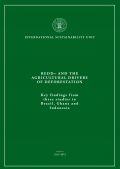This report reviews the economic and environmental consequences of resource inefficiency in Asia and the Pacific and some of its underlying causes. It examines a range of technical, policy, and institutional responses to encourage corporations and consumers alike to adopt more resource-efficient behaviors, with particular attention to the vital role governments must play in creating incentive structures, encouraging research and development for new technologies, improving institutions and information exchange, and other measures to move the region’s economies toward greater resource efficiency. This analysis is a contribution to the global G8 3R Initiative, which seeks to promote the “reduce, reuse, recycle” approach to waste management. While many of the specific strategies described are not new, the report should contribute to an understanding of the underlying reasons behind resource inefficiency, tools for its analysis, and specific interventions tailored to the Asia and Pacific context.
The report includes case studies from China, India, Japan, Lao, Nepal, Philippines and Thailand.
This document is a review of the low carbon growth studies conducted in six emerging economies: Brazil, China, India, Indonesia, Mexico and South Africa. These countries, with the help of the Energy Sector Management Assistance Programme (ESMAP), have initiated country specific studies to assess development goals in conjunction with greenhouse gas mitigation opportunities. The aim is to present a framework for other countries who wish to implement studies of their own.
The paper is structured to mirror the seven step process of establishing a low carbon growth country study.
This paper highlights the implications of the current separation of the discourses on private climate finance (PCF) and on subsidies, and the opportunities that exist to unlock climate-compatible investment by linking these fields.
Though climate finance aims to enable climate compatible development (CCD), this paper points out that, within developing countries, subsidies to fossil fuels (alone) currently dwarf any efforts toward CCD through climate finance.
This report summarizes the results of a recent review of the emerging experience with the design and implementation of policy instruments to promote the development of renewable energy (RE) in a sample of six representative developing countries and transition economies ('developing countries') (World Bank 2010). The review focused mainly on price- and quantity-setting policies, but it also covered fiscal and financial incentives, as well as relevant market facilitation measures. The lessons learned were taken from the rapidly growing literature and reports that analyze and discuss RE policy instruments in the context of different types of power market structures. The analysis considered all types of grid-connected RE options except large hydropower: wind (on-shore and off-shore), solar (photovoltaic and concentrated solar power), small hydropower (SHP) (with capacities below 30 megawatts), biomass, bioelectricity (cogeneration), landfill gas, and geothermal. The six countries selected for the review included Brazil, India, Indonesia, Nicaragua, Sri Lanka, and Turkey.

In order to ensure global food security and avert dangerous climate change, the world faces the pressing dual challenge of both protecting its remaining rainforests and enhancing food production in sustainable and resilient ways. Successfully achieving this would provide multiple co-benefits, including safeguarding the well-being and livelihoods of forests peoples; protecting the biodiversity and ecosystems provided by forests; and reducing rural poverty.
